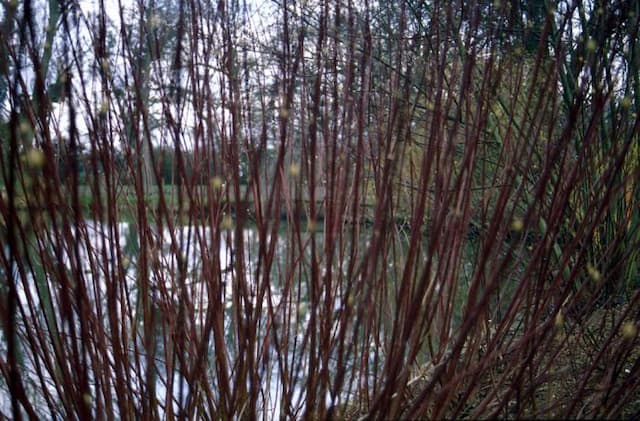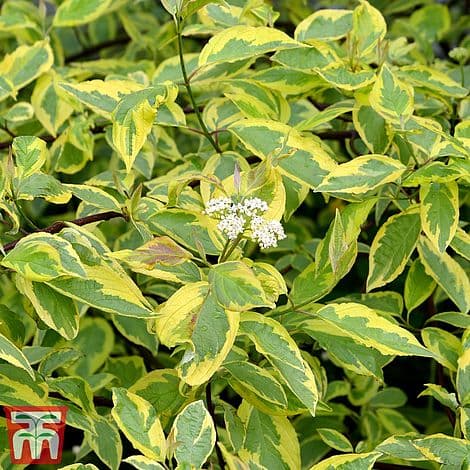Flowering Dogwood Cornus florida 'Cherokee Chief'











ABOUT
The Cherokee Chief Dogwood is a visually striking ornamental tree. It boasts large, showy bracts that are often mistaken for flowers; these bracts are a deep, rosy-pink color. The true flowers are actually quite small and cluster in the center of the conspicuous bracts. During the blooming season, this adornment gives the plant a very distinctive and attractive appearance. The leaves of the Cherokee Chief are ovate-shaped and have a lustrous, green color that turns to a rich red-purple in the fall, adding another layer of visual interest. The foliage arrangement is opposite, meaning leaves grow in pairs directly across from one another on the branches. After the flowering period, the plant produces glossy red fruits that are popular among birds and wildlife, though they are not particularly fit for human consumption. The bark on the Cherokee Chief Dogwood is also notable for its textured, blocky patterns that give it a distinctive, rugged look. Overall, the Cherokee Chief Dogwood is cherished for its year-round beauty, from the springtime blooms to the autumn foliage and textured winter bark, making it a favorite for landscaping purposes.
About this plant
 Names
NamesFamily
Cornaceae.
Synonyms
Cherokee Chief Dogwood, Flowering Dogwood, American Dogwood, Cornelian Tree, Dogwood.
Common names
Benthamia florida, Benthamidia florida, Cynoxylon floridum.
 Toxicity
ToxicityTo humans
The Flowering Dogwood is not considered highly toxic to humans. However, it does contain certain compounds in its leaves, bark, and fruit that can be mildly toxic if ingested in large quantities. Symptoms from ingesting parts of the plant can include vomiting, diarrhea, and stomach pain. It is always advisable to avoid eating any part of ornamental plants unless they are known to be edible.
To pets
The Flowering Dogwood is considered to have a low level of toxicity to pets. While it is not typically lethal, eating parts of the plant, such as the leaves, bark, or fruit, can cause gastrointestinal distress in dogs and cats, leading to symptoms such as vomiting and diarrhea. It is generally recommended to prevent pets from ingesting the plant to avoid any potential discomfort or health issues.
 Characteristics
CharacteristicsLife cycle
Perennials
Foliage type
Deciduous
Color of leaves
Green
Flower color
Red
Height
20 feet (6 meters)
Spread
25 feet (7.62 meters)
Plant type
Tree
Hardiness zones
5
Native area
North America
Benefits
 General Benefits
General Benefits- Ornamental Value: 'Cherokee Chief' is known for its vibrant bracts, which are often mistaken for flowers, and add significant aesthetic value to landscapes.
- Wildlife Attraction: The tree produces berries that attract birds, providing an essential food source for various species of wildlife.
- Shade Provider: The dense foliage offers ample shade, which can be beneficial in garden settings or when planted as a street tree.
- Seasonal Interest: 'Cherokee Chief' has a striking presence throughout the seasons with pink to red bracts in the spring, green leaves in the summer, and reddish-purple leaves in the fall.
- Soil Erosion Control: The root system can help stabilize the soil and prevent erosion, particularly on slopes or areas prone to runoff.
- Low Maintenance: Once established, it requires minimal upkeep, making it suitable for gardeners of all skill levels.
- Privacy Screen: When planted in a row or group, it can provide a dense visual barrier, enhancing privacy and reducing noise pollution.
- Cultural Significance: This particular cultivar appeals to those interested in Native American heritage and the use of native plants in landscaping.
- Drought Resistance: After establishment, Cornus florida 'Cherokee Chief' can tolerate periods of drought, reducing the need for frequent watering.
 Medical Properties
Medical PropertiesThis plant is not used for medical purposes.
 Air-purifying Qualities
Air-purifying QualitiesThis plant is not specifically known for air purifying qualities.
 Other Uses
Other Uses- Photography Accent: The vibrant red flowers of the Dogwood 'Cherokee Chief' provide striking contrast in landscape photography, often serving as a natural focal point.
- Winter Interest: During the winter, when the leaves fall, the Dogwood 'Cherokee Chief' exhibits bright red fruits and a distinctive branching pattern that adds texture and interest to a bare garden.
- Dye Production: The bark and roots of the Dogwood can be used to create natural dyes for fabrics and crafts, offering shades of brown and muted red.
- Wildlife Shelter: The dense foliage and branches of the Dogwood offer excellent shelter and nesting sites for birds and small mammals.
- Ink Making: Historically, extracts from the Dogwood's bark and fruits have been used to make inks for writing and drawing.
- Holiday Decorations: Branches, berries, and blossoms of the Dogwood 'Cherokee Chief' are utilized for making wreaths and other holiday decorations due to their visually appealing color and structure.
- Cultural Symbolism: Due to its beauty and four-petaled flowers, the Dogwood 'Cherokee Chief' is sometimes used for symbolic purposes in festivals or ceremonies representing purity and renewal.
- Educational Tool: This plant can be used to teach botany and horticulture, including lessons on plant biology, propagation, and the impact of soil pH on flower color.
- Soil Erosion Control: The root system of the Dogwood helps stabilize soil, making it a practical choice for planting in areas prone to erosion, such as slopes and riverbanks.
- Artistic Inspiration: The distinctive form and flower of the Dogwood 'Cherokee Chief' frequently inspire artists and designers, influencing patterns in textiles, paintings, and ornamental designs.
Interesting Facts
 Feng Shui
Feng ShuiThe Flowering Dogwood is not used in Feng Shui practice.
 Zodiac Sign Compitability
Zodiac Sign CompitabilityThe Flowering Dogwood is not used in astrology practice.
 Plant Symbolism
Plant Symbolism- Resilience: The Cherokee Chief Dogwood, known for its ability to withstand challenging conditions, represents strength and the ability to endure adversity.
- Beauty in Nature: With its striking red blooms, the Cherokee Chief Dogwood is symbolic of the natural beauty that can be found in the world around us.
- Rebirth and Renewal: As a tree that flowers in the spring, it is often associated with new beginnings and the idea of rejuvenation and fresh starts.
- Purity: The dogwood flower's traditional association with purity is reflected in the Cherokee Chief's pristine and bold-colored blossoms.
- Christian Symbolism: In Christian symbolism, the dogwood is often associated with the crucifixion of Jesus, as it is said that the dogwood was used to construct the cross. The shape of the dogwood flower is sometimes interpreted to resemble a cross, with the four petals.
 Water
WaterThe Flowering Dogwood (Cornus florida 'Cherokee Chief') requires regular watering to ensure the soil remains consistently moist but not waterlogged. During the growing season in spring and summer, water the plant deeply once a week using approximately 1 to 1.5 gallons per watering session, depending on the size and age of the tree and weather conditions. Reduce watering in the fall and further in winter when the tree is dormant, but do not allow the soil to completely dry out. Adjust the watering frequency based on rainfall, lessening the amount if there has been significant rain. Ensure that the water reaches deep into the root zone to encourage healthy root development.
 Light
LightFlowering Dogwoods prefer dappled sunlight or partial shade, especially in the hotter parts of their range. Position the Cherokee Chief where it can receive morning sunlight and afternoon shade or filtered light beneath taller trees to protect it from the intense midday sun. Avoid full sun exposure in hotter regions as it can stress the plant and lead to leaf burn.
 Temperature
TemperatureFlowering Dogwoods thrive in a temperate climate and can handle a temperature range from approximately 0°F to 85°F. They are hardy to USDA Zones 5 through 9. The ideal temperature for optimal growth and flowering for Dogwoods is between 65°F and 75°F. Protection from extreme cold and heat is beneficial to the health of the tree.
 Pruning
PruningFlowering Dogwoods benefit from pruning to remove dead or diseased branches, improve their shape, and promote healthy growth. Prune the Cherokee Chief in late winter or early spring before new growth starts, as the tree is still dormant. Thinning out crowded branches can improve air circulation, which reduces the risk of disease. Some light shaping can also be done after flowering to maintain an attractive tree form without affecting the next season's blooms.
 Cleaning
CleaningAs needed
 Soil
SoilFlowering Dogwood 'Cherokee Chief' thrives in an acidic to neutral soil mix (pH 5.5 - 6.5). A well-draining soil rich in organic matter is ideal, so a blend of loam, peat moss, and perlite can provide the necessary conditions for healthy growth.
 Repotting
RepottingFlowering Dogwoods, such as 'Cherokee Chief', do not require frequent repotting and are often repotted every 2-3 years to refresh the soil or accommodate root growth.
 Humidity & Misting
Humidity & MistingThe Flowering Dogwood 'Cherokee Chief' prefers moderate humidity but is adaptable to a range of conditions found in typical outdoor settings.
 Suitable locations
Suitable locationsIndoor
Place in well-lit room, avoid hot, dry air.
Outdoor
Plant in partial shade, shelter from harsh winds.
Hardiness zone
5-9 USDA
 Life cycle
Life cycleThe Flowering Dogwood 'Cherokee Chief' begins its life cycle as a seed, which requires stratification to break dormancy before it can germinate in the spring. Once germinated, the seedling grows, establishing a root system and developing shoots that will form the iconic branching patterns of the tree. As it matures into a young tree, it undergoes primary growth, elongating in height and girth. Later, the dogwood enters a reproductive phase, typically around 3 to 5 years of age, where it starts producing the striking red to dark pink flowers that are actually modified leaves (bracts) surrounding small, inconspicuous flowers. Following pollination, these flowers develop into clusters of berry-like drupes that are a food source for wildlife. As a perennial, the dogwood continues its cycle of growth and reproduction annually, while as it ages, it eventually reaches senescence, where growth slows, and the tree may become more susceptible to disease and environmental stress before dying.
 Propogation
PropogationPropogation time
Spring to Early Summer
The Flowering Dogwood, known scientifically as Cornus florida 'Cherokee Chief', is most commonly propagated through the method of semi-hardwood cuttings. This form of asexual propagation typically takes place in the late summer when the current season's growth has begun to mature and harden slightly. To successfully propagate, a healthy branch is selected and a cutting of about 4 to 6 inches long (10 to 15 centimeters) is made. The cutting should have several leaves and should be taken from a portion of the branch that is not too woody nor too green. The cut end is then dipped into rooting hormone to encourage root development and planted in a well-draining soil mix. It should then be kept in a humid environment, such as a mist bench or under a plastic cover, to maintain moisture while the cutting forms roots. Regularly checking for root formation, usually within a few weeks to a couple of months, and ensuring the medium doesn't dry out are key to successful propagation.









